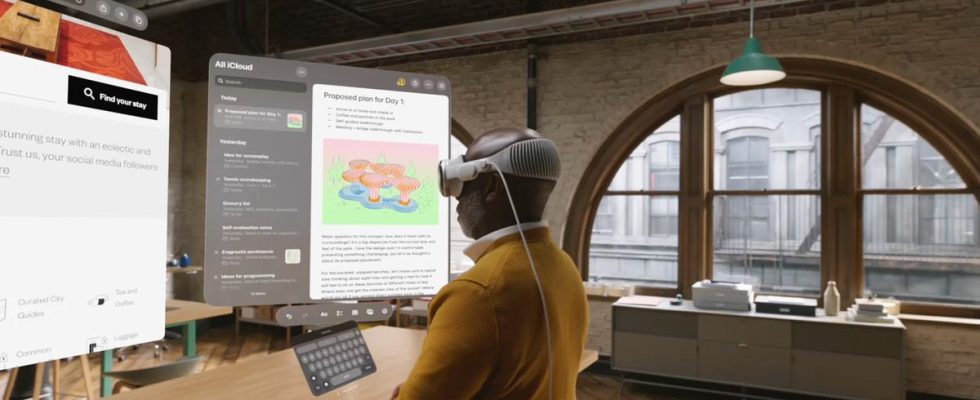“Today marks the beginning of a new era for computing. After years of rumors, Tim Cook on Monday unveiled the Apple Vision Pro, a “mixed” reality headset that will be launched in early 2024 in the United States. After the PC and the smartphone, Apple is betting on “spatial” computing, with an immersion that mixes the real and the virtual around the user, without necessarily cutting him off from the outside world. But with a price starting at $3,499, this Vision Pro seems primarily aimed at wealthy developers and enthusiasts, and it will have to prove that the market can finally take off.
How much will it cost and when will it be available?
Apple has done this in advance: the Vision Pro will be launched in early 2024 in the United States, and in the months that follow in other countries. It is not immediately known whether France will be part of it. With this limited launch and a price starting at $3,499, the headset is not aimed at the general public. Apple is targeting professionals and especially developers, with an urgent need for a “killer app” making technology essential.
The Vision Pro is significantly more expensive than the first iPhone, launched in 2007 at $499 (equivalent to today’s $725), but less than the Apple Computer II, which in 1977 cost the equivalent of today’s $6,500. . In the virtual reality market, Apple’s headset will have to find a place between Meta’s Quest 3 ($499), expected in the fall, and the Varjo XR-3 ($6,495) on which fighter pilots and surgeons.
What resolution and how much battery life?
The helmet has two micro-Oled panels the size of postage stamps comprising a total of 23 million pixels. It’s more than a 4K TV in front of each eye. It is an “all in one” device, which does not need to be connected to a computer. Unfortunately, the Vision Pro is primarily designed for mains use, although a portable battery pack will provide up to 2 hours of battery life. For those who wear glasses, corrective optical inserts from Zeiss will be sold separately and will magnetically clip to the screens.
How does Apple mix the real and the virtual?
For a long time, it was necessary to choose between virtual reality, ultra-immersive but which isolates from the outside world, and augmented reality. The latter allows you to see the world behind a transparent screen on which synthetic images are embedded. Problem, the contrasts are weak, and the field of vision limited, as on the Microsoft HoloLens helmet or the Magic Leap glasses.
Apple, like Meta or HTC, puts a hybrid experience of extended reality (extended reality or XR in English). The Vision Pro embeds a dozen cameras and 3D sensors that allow you to superimpose the virtual on a video stream of your environment. It was very rudimentary until recently, and served above all to avoid bumping, but the “passthrough” technology has made immense progress, with 4K video in color and latency, Apple promises, imperceptible. The “digital crown” wheel controls the level of presence, to meditate in front of a peaceful lake or work on an Excel table that floats above his desk.
The Apple firm also uses this “passthrough” magic trick in reverse: facing an interlocutor, the headset can simulate a transparency effect to display an image of the user’s eyes on the integrated screen at the front of the helmet. Apple seeks to make the experience as less anti-social as possible.
Which interface to navigate?
No joystick or gloves: everything works with eyes, voice and gestures. Eye tracking detects where you are looking, and small gestures allow you to select a menu or scroll through a page, like Robert Downey Jr in Iron Man or Tom Cruise in Minority Report. For video games, with a hundred Apple Arcade titles expected at launch, a controller can be used. For office automation, the headset is compatible with the Magic keyboard/trackpad.
Which OS and which applications?
This is where Apple shines. The Cupertino company presented visionOS, a “space” operating system that integrates many home applications. FaceTime allows, for example, to display your interlocutors around you and to take advantage of spatial audio. You can also scan your face to create a 3D avatar much less cartoonish than those of Facebook, with emotions and reactions transcribed in real time. 3D videos allow you to immerse yourself in the middle of a magical world or a photo taken in panorama.
Will this be enough to revive a sector in difficulty?
This is the great unknown. According to Insider Intelligence, less than 10% of the American population uses a virtual reality headset once a month. According to leaks relayed by The Verge, Meta has sold around twenty million Quest headsets. Mark Zuckerberg has bet it all on the Metaverse, but this year Silicon Valley only has eyes for AI.
Apple, for its part, rarely arrives first, preferring to wait until technology has advanced enough to offer an innovative and accessible experience to the general public. By controlling the Vision Pro from end to end, from the graphics chips to the OS, and by exploiting an ecosystem used by more than a billion people, the Apple firm is ideally placed. But the pandemic has proven that we want more real and less virtual, more human contact and fewer screens. Even less when they are attached to our head.

